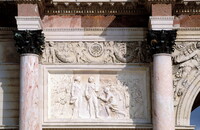Arc de Triomphe du Carrousel
Percier, Charles; Fontaine, Pierre-François-Léonard

Download1A2-F-P-ATC-B3_cp.jpg (563.3Kb)
Date
1806-1807Description
West elevation, detail of the reliefs, upper north side; The Arc de Triomphe du Carrousel is a triumphal arch in Paris, France. It is located on the Place du Carrousel, just to the west of the Louvre. Designed by Charles Percier and Pierre Léonard Fontaine, the arch was made between 1806-1808 by the Emperor Napoleon I on the model of the Arch of Septimius Severus in Rome. It was commissioned to commemorate France's military victories in 1805. It was originally surmounted by the famous horses of Saint Mark's Cathedral in Venice, captured by Napoleon, but these were returned to Venice in 1815. They were replaced by a quadriga sculpted by Baron François Joseph Bosio, depicting Peace riding in a triumphal chariot, led by gilded Victories on either side; the composition commemorates the Restoration of the Bourbons following Napoleon's downfall. The Arc de Triomphe du Carrousel is at the easternmost end of the so-called "Axe historique" ("grand historic axis") of Paris, a nine-kilometre long linear route which dominates central and western Paris created under the (later) city planning of Baron Haussmann. Looking west towards , the arch is perfectly aligned with the obelisk in the Place de la Concorde, the Champs-Élysées, the Arc de Triomphe and (although it is not directly visible from the Place du Carrousel) the Grande Arche de la Defense. The axis thus begins and ends with an arch today. Source: Wikipedia; http://en.wikipedia.org/wiki/Main_Page (accessed 6/20/2008)
Type of Work
monument; triumphal arch (memorial arch)Subject
allegorical, architectural exteriors, military, war, mythology (Classical), Napoleon I, Emperor of the French, 1769-1821, victory arch, triumphal arch, "Haussmannization", Voie Triomphale, triumphal way, memorial, Nineteenth century, Empire
Rights
Rights Statement
Licensed for educational and research use by the MIT community only